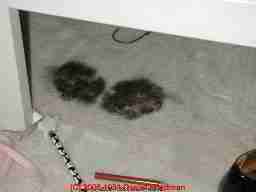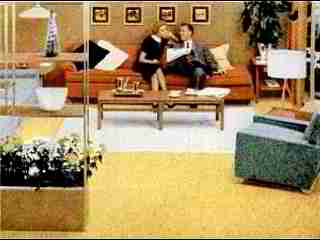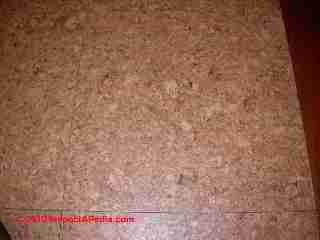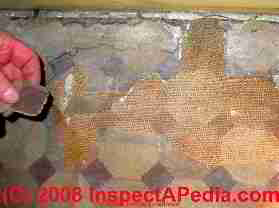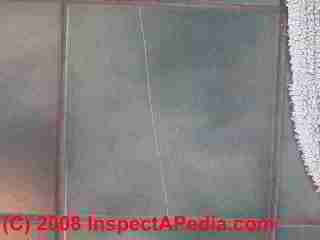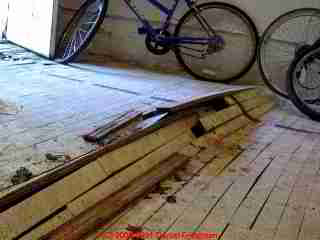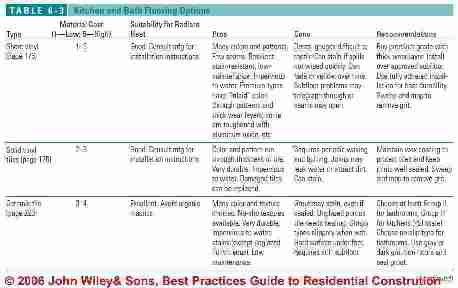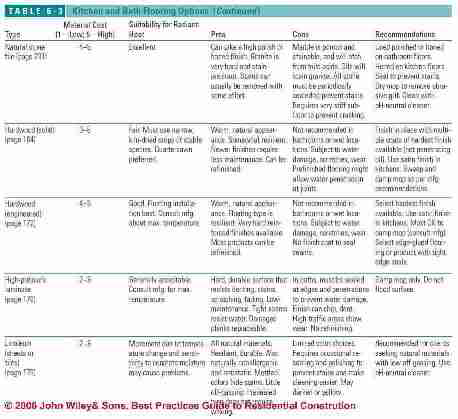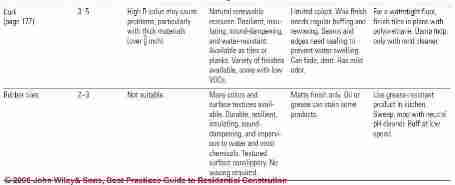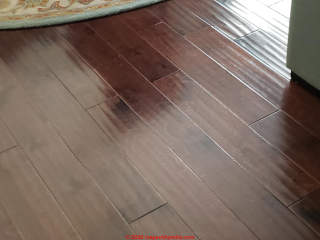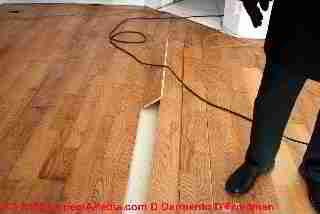 Guide to All Types of Building Flooring Materials & Flooring Defects
Guide to All Types of Building Flooring Materials & Flooring Defects
- POST a QUESTION or COMMENT about identifying types of flooring materials & flooring problem troubleshooting
Flooring types & properties:
This article provides information about all types of flooring and floor coverings used in buildings. This article series provides the properties of different flooring types, flooring defects, inspection, troubleshooting, installation or flooring repairs. Asbestos, mold or other flooring hazards are described as well as how to identify types of flooring or to guess building age or flooring age.
Here we provide a list of building flooring articles that guide in identifying different kinds of flooring materials in buildings and we include articles on individual flooring type inspection, diagnosis, & repair. At the end of this article you will find the master index to articles about floors and flooring. Also try searching for specific flooring information at InspectApedia by using the page top or page bottom search boxes.
InspectAPedia tolerates no conflicts of interest. We have no relationship with advertisers, products, or services discussed at this website.
- Daniel Friedman, Publisher/Editor/Author - See WHO ARE WE?
Articles on types, ages, characteristics, ingredients, & inspection of different types of floor coverings
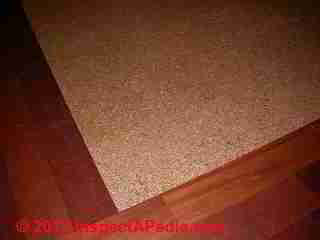 Article Series Contents
Article Series Contents
- FLOOR TYPES & DEFECTS
- ASBESTOS ASBESTOS FLOOR TILES
- ASPHALT TILE FLOORING
- CARPETING & RUGS
- CERAMIC TILE FLOORING (or WALLS)
- CONCRETE FLOORING
- CORK FLOORING
- FLOOR TILE HISTORY & INGREDIENTS
- HARDWOOD FLOORING
- KITCHEN & BATH FLOORING
- LAMINATE FLOORING - Engineered Wood Floors
- LINOLEUM SHEET FLOORING
- MOLD CONTAMNIATION IN / ON FLOORING
- NON-RESILIENT FLOOR COVERINGS
- PROPERTIES of FLOORING, TABLE-OF
- PEEL & STICK FLOOR TILES
- RESILIENT FLOOR COVERINGS
- SHEET FLOORING TYPES
- STONE FLOORING
- TILE FLOORING, CERAMIC
- TILE FLOORING, RESILIENT
- VINYL ASBESTOS FLOOR TILES
- WOOD FLOORING, SOLID STRIP or ENGINEERED WOOD
- ASBESTOS FLOOR TILE IDENTIFICATION PHOTOS 1949-1959 - separate article
- FLOOR TILE HISTORY & INGREDIENTS - separate article
- FLOORING MATERIALS, Age, Types - separate article
- FLOOR TILE / SHEET FLOORING PHOTO GUIDES - list of photo guides
Asbestos Containing Floor Materials
Details begin at these articles useful to identify asbestos-containing floor tiles or sheet flooring
- FLOOR TILE ASBESTOS IDENTIFICATION
- ASBESTOS FLOOR TILE IDENTIFICATION PHOTOS 1949-1959
- FLOOR TILE HISTORY & INGREDIENTS
- ASBESTOS FLOOR TILE LAB PROCEDURES
Asphalt Tile Flooring - 1920 - 1960 (est)
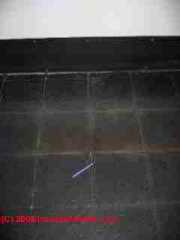 Asphalt floor tiles are most often 9" square tiles which used asphalt as the main binding material. Asphalt and asphalt asbestos flooring was produced and sold in a range of sizes including 6x6", 9x9", 12x12" and also in strips or decorative insets.
Asphalt floor tiles are most often 9" square tiles which used asphalt as the main binding material. Asphalt and asphalt asbestos flooring was produced and sold in a range of sizes including 6x6", 9x9", 12x12" and also in strips or decorative insets.
The original asphalt tiles were produced only in dark colors because asphalt was a main ingredient. Asphalt based floor tiles usually contain asbestos as both a powder filler (very small asbestos particles) and as a fiber for strength and are often referred to as asphalt-asbestos floor tiles. However later lighter-colored vinyl-based floor tiles may also contain asbestos.
The black tiles shown at left were not dated and could be a newer product, but in general, if you find dark colored or very old black floor tiles or floor tiles that are black in their core materials they are probably an asphalt-asbestos product.
Rosato indicates that the first publicized asphalt tile installation was in 1920 in New York City's Western Union office. The product was very successful and by 1936 over four million square yards of asphalt floor tiles were being sold annually.
In 1920 asphalt roofing manufacturers, who had been using asphalt and fiber binders to make asphalt roofing shingles for some time, tried to develop a rigid product that could be a substitute for (more costly) slate roofing. The material did not perform acceptably as a roof covering, but it led to the development of asphalt floor tiles.
By 1940, 5% of floor coverings sold in the U.S. were asphalt tile. - - Rosato Through the 1950's and 1960's most floor tiles sold in North America and parts of the U.K., Europe, Australia, New Zealand, parts of India and other countries were asphalt asbestos flooring, shifting to vinyl based tiles and vinyl-asbestos floor tiles and sheet flooring that were widely sold into the early 1980's in most locales.
At AGE of a BUILDING, HOW to DETERMINE in our section titled Flooring Materials we discuss the eras during which various flooring materials were first used in modern buildings and how to use these to help identify the age of a building.
Asphalt Floor Tiles Pose an Asbestos Risk
Asphalt-asbestos floor tiles were produced at first in dark colors using a heavy asphalt binder combined with a very high percentage of asbestos filler fibers.
It would be uncommon to find these floors still in use today, but if you encounter black or very dark asphalt floor tiles they are probably very high in asbestos fibers. We discuss floor tiles as an asbestos fiber source in buildings in more detail
- by (mod) -
at ASBESTOS FLOORING IDENTIFICATION
where we elaborate the concerns about asbestos used in the manufacture of asphalt-based floor tiles.
That does not mean we should panic nor undertake an expensive and dangerous asbestos removal project.
Asbestos is safe and legal to remain in homes or public buildings as long as the asbestos materials are in good condition and the asbestos can not be released into the air.
Generally the safest approach is to leave such flooring alone and to cover it over with a coating or with another layer of flooring.
- On any of our asbestos-related InspectApedia pages you will find a
complete ARTICLE INDEX to ASBESTOS HAZARDS - See ASBESTOS FLOORING HAZARD REDUCTION for strategies to leave or cover-over asbestos-suspect flooring.
- If you are faced with a requirement for demolition and if you are uncertain about the flooring's asbestos content and cannot identify it through our guides, then you have a sample tested.
See ASBESTOS TESTING LAB LIST - If conditions require you to demolish or remove asbestos-containing flooring
see ASBESTOS FLOORING REMOVAL GUIDE
Colors & Composition of Asphalt Asbestos Floor Tiles
Asphalt -asbestos tiles manufactured early in their life (1920's) were either black, near black, brown, or a gray-brown tone. Brown asphalt-asbestos tiles were made by substituting gilsonite as a binder. In both cases the tiles were hardened by evaporating a solvent used in the fabrication process, or by cooling of hot asphalt used in the mixture.
Gilsonite could be used to produce a wider range of mixtures, but required some asphalt as a softener. Dark vinyl-asbestos tiles used, for example, a mixture of 40 parts asphalt or gilsonite, 60 parts asbestos floats, 30 parts powdered limestone, and pigments (parts by weight). Another typical mixture cited by Rosato contained 70% asbestos fiber.
See these articles on asphalt and vinyl-asbestos floor tile identification:
- ASBESTOS FLOORING IDENTIFICATION - How to Identify Floor Tiles That May Contain Asbestos
- ASBESTOS FLOOR TILE IDENTIFICATION PHOTOS 1949-1959 - detailed photo guide to asphalt asbestos and vinyl asbestos floor tiles, 1900 -1986
- FLOOR TILE HISTORY & INGREDIENTS - history, dates, and description of the production process and ingredients in asphalt floor tiles, asphalt-asbestos floor tiles, & vinyl-asbestos floor tiles 1900 to present.
- FLOORING MATERIALS, Age, Types - Age of Building Flooring Materials - A Guide to Estimating Building Age, This article describes types and ingredients in flooring materials: Asphalt floor tile, Cork floor tile or planks, Laminate flooring (modern), Linoleum & older sheet flooring (painted canvas), Vinyl-asbestos floor tiles, Wood flooring.
- FLOOR TYPES & DEFECTS - Asphalt floor tiles, asphalt-saturated asbestos felt, carpeting, cork floor tiles & planks, laminate flooring (modern), linoleum (sheet flooring) & earlier painted fabric floor coverings, vinyl-asbestos tile floors, wood flooring.
- ASBESTOS FLOOR TILE LAB PROCEDURES - photos of how vinyl asbestos flooring is analyzed in the lab.
Carpeting - wall to wall carpets
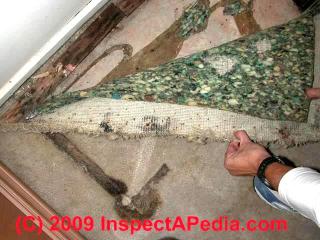
Carpet may be synthetic or natural fibers like wool. Synthetic carpeting is the most common
and is a good choice in areas where the carpeting may become wet.
Common wall to wall carpeting materials
include polypropylene, nylon and acrylic. Where the backing material is not moisture resistant, synthetic carpet will be quickly damaged if wet. Jute-backed carpets, for example, should be kept dry.
Many types of synthetic carpet can be cleaned more easily than wool carpets.
Synthetic carpeting is available in a wide variety of colors, weights and weaves.
Wool is an expensive material favored for its look, feel and durability. As synthetic products have improved and remain less expensive, wool is becoming rare.
It is sometimes blended with a synthetic material. Wool is a natural product and is less resistant to water damage than synthetics. It also has less resistance to stains than some synthetics.
The quality of a carpeted floor depends upon the type, weight and construction of carpeting, the type of underpad, and the installation work.
- Citation: Carson Dunlop Associates, Home Reference Book, quoted with permission.
See these detailed articles about carpeting:
- CARPET DUST IDENTIFICATION
- CARPET MOLD / ODOR TESTS
- CARPET PADDING ASBESTOS, MOLD, ODORS
- CARPET STAIN DIAGNOSIS
- CARPET STAIN ID TESTS
- CARPET AIR LEAK STAINS at WALLS
- CARPET CONTAMINATION TEST PROCEDURE
- CARPETING & INDOOR AIR QUALITY
- CARPETING, SELECTION & INSTALLATION
Wall-to-wall Floor Carpeting Inspection, Diagnosis, Repair
See these articles about diagnosing stains, mold, and allergens in carpeting
- CARPET DUST IDENTIFICATION
- CARPET MOLD / ODOR TESTS
- CARPET PADDING ASBESTOS, MOLD, ODORS
- CARPET STAIN DIAGNOSIS
- CARPET STAIN ID TESTS
- CARPET AIR LEAK STAINS at WALLS
- CARPET CONTAMINATION TEST PROCEDURE
- CABINETS & COUNTERTOPS
- CARPETING & INDOOR AIR QUALITY
- CARPETING, SELECTION & INSTALLATION
- Thermal Tracking: How to Diagnose Indoor Carpeting Stains Due To Building Air Leaks
- How to Find and Test for Moldy Carpeting in buildings
- Carpet Test for Mold: How to Collect Test Samples from Carpets & Soft Surfaces
Ceramic Tile Flooring Articles
Concrete Flooring & floor finishes
Concrete floor finishes are typically only used in basements and garages. The floor should slope down to a floor drain in basements and other areas where water may accumulate.
In modern construction, a four to six inch gravel base below the 3-inch thick floor slab allows water below the slab to drain away. Moisture barriers (plastic sheets) may also be provided under the slab, and in energy efficient construction or slab-on-grade construction, rigid insulation may be used below the floor.
In older construction, concrete floor slabs were as thin as 1/2 inch. These are prone to impact damage, heaving and break-up.
This is a cosmetic issue and may be a trip hazard.
Most concrete floors are not part of the structure. Basement floors are typically installed after the home is completed, and their main function is to keep our feet out of the mud.
Concrete basement floors can be overlaid with finished flooring. Since almost every house with a basement has water on the basement floor at some point, water-resistant floors make sense.
In slab-on-grade construction, the concrete floors provide a substrate for floor finishes. - Citation: Carson Dunlop Associates, Home Reference Book , quoted with permission.
Concrete Floor details are in these articles
Cork Flooring & Cork Tiles
Details about cork flooring are at these articles
- CORK FLOORING - home
- CORK FLOORING & FLOOR TILES - age of flooring
- FLOORING COMPANIES - companies producing flooring
Floor Tile History & Inredients
- FLOOR TILE HISTORY & INGREDIENTS - history, dates, and description of the production process and ingredients in asphalt floor tiles, asphalt-asbestos floor tiles, & vinyl-asbestos floor tiles 1900 to present.
- FLOORING MATERIALS, AGE, TYPES - Age of Building Flooring Materials - A Guide to Estimating Building Age, This article describes types and ingredients in flooring materials: Asphalt floor tile, Cork floor tile or planks, Laminate flooring (modern), Linoleum & older sheet flooring (painted canvas), Vinyl-asbestos floor tiles, Wood flooring.
Asphalt floor tiles, asphalt-saturated asbestos felt, carpeting, cork floor tiles & planks, laminate flooring (modern), linoleum (sheet flooring) & earlier painted fabric floor coverings, vinyl-asbestos tile floors, wood flooring.
Kitchen & Bath Floor Options - Table comparing properties of different flooring materials
See
FLOOR, KITCHEN & BATH OPTIONS
Laminate Flooring, Plastic Laminate Floors and Engineered Wood floors
 In recent years, laminate flooring has become very popular, especially among do-it-yourselfers. Laminate floor planks (or tiles) have several layers. The top layer is generally a clear laminate that is bonded to a decorative layer below, often creating the look of a wood floor.
In recent years, laminate flooring has become very popular, especially among do-it-yourselfers. Laminate floor planks (or tiles) have several layers. The top layer is generally a clear laminate that is bonded to a decorative layer below, often creating the look of a wood floor.
These layers are bonded to a wood- or fiber-based core.
The bottom layer may be a paper or melamine backing. The product is similar to resilient countertops.
A complete floor is created by either snapping planks together with specially-designed fasteners along the edges, or by gluing planks together along traditional tongue and groove edges.
Laminate flooring is not secured to the subfloor beneath it. Instead, it is installed as a floating floor, allowing it to expand and contract. A sheet of cushioning foam is installed between the laminate flooring and the subfloor. There may also be a sheet of plastic below the foam to act as a moisture barrier and to allow the floor to slide as it expands. A gap is required between the flooring and the walls to allow for expansion. This gap is covered by trim.
Laminate flooring cannot be sanded, stained, or otherwise refinished, although damaged planks can be replaced.
Laminate flooring is resistant to small amounts of water, such as quickly wiped-up spills, but precautions should be taken in kitchens or bathrooms including applying a sealant around the perimeter. This is not visible during a home inspection. Laminate flooring should not be installed in damp basement areas. - Citation: Carson Dunlop Associates, Home Reference Book , quoted with permission.
The laminate wood flooring shown at above left was buckled and destroyed by flooding caused by a leaky heating pipe. As we discussed with traditional wood flooring above, severe flooding or installation errors can lead to total loss of the finish floor system.
Contemporary snap-together flooring products that resemble wood or other surfaces, but are made of plastic, and other pre-finished and ready-to-assemble wood flooring products are a much more modern product.
Pergo ™ laminate flooring, for example, was developed by Pergo AB, a Swedish company founded around 1890 as a vinegar manufacturer. Product development for Pergo laminate flooring began in 1977 and was first brought to the market in 1984. Pergo laminate flooring was first sold in the U.S. in 1994.
It's safe to say that if you see a Pergo product in building in U.S. the flooring was installed no longer ago than 1994. But because this product is has been widely used as a renovation material installed atop older pre-existing finish floor surfaces, one should not presume that the product age is the same as the building age unless the floor was installed as original material - that is, unless it was not installed over an older floor covering.
Just seeing Pergo™ laminate flooring over a plywood subfloor is not sufficient data to conclude the age of a home. Older carpeting may have been removed to expose a plywood subfloor over which the laminate flooring was then installed.
See these detailed articles on laminate floor materials:
- FORMALDEHYDE in LAMINATE FLOORING
- LAMINATE PLASTIC FLOORING
- LAMINATE WOOD & Other Laminate Floors
- WOOD FLOORING & Engineered Wood Floors
Linoleum Flooring articles
Shown at below, Congoleum sheet flooring
Mold on or hidden in flooring
- CAR MOLD CONTAMINATION - mold contamination of carpeting, headliners, wall panels and other components in cars, boats, trucks, RVs
- FLOOR & SUBFLOOR MOLD, HIDDEN
Non-Resilient Floor Coverings
Non-resilient floor coverings used in buildings that can assist in determining the age of a structure include bamboo, brick, concrete, stone, and a wide variety of wood products.
Resilient Flooring
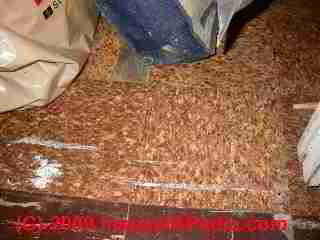
Resilient floor coverings include vinyl-asbestos, solid vinyl, vinyl faced, rubber, cork, asphalt and linoleum. It is installed in sheets or tiles. More expensive products include a cushioned backing material and a no-wax surface.
Above: vinyl asbestos flooring in a cork pattern - this is considered a resilient flooring material.
Below: cork floor tiles (actual cork) - this is considered a resilient flooring material too.
In modern construction, resilient floor covering materials are typically applied over a 1/4 inch plywood
underlayment. These thin, flexible materials will show through any irregularities in the floor surface. - Citation: Carson Dunlop Associates, Home Reference Book
See:
- ASPHALT TILE
- CORK FLOORING - home
- CONGOLEUM-NAIRN FLOOR TILES & LINOLEUM - resilient sheet flooring and floor tiles
- FLOOR, RESILIENT VINYL or CORK - home - best installation practices for modern sheet or resilient flooring
- LINOLEUM & SHEET FLOORING - how to identify antique or older sheet flooring focused on linoleum and linoleum-look-alike products
- MASTIC, CUTBACK ADHESIVE - some flooring adhesives contained asbestos
- VINYL ASBESTOS FLOOR TILES
- PEEL & STICK / Self-Adhesive Floor Tiles - types of self-adhesive floor tiles and peel and stick tiles intended for consumer installation
- RESLILEINT FLOOR TYPES
- RESILIENT SHEET FLOORING ID GUIDE - how to identify types of resilient sheet flooring that contain asbestos, might contain asbestos, or don't contain asbestos
- SHEET & TILE FLOORING ASBESTOS ID-BRICK PATTERN ID - some of these contain asbestos, some not.
- SHEET FLOORING MATERIALS
Sheet Flooring Materials & Building Age
Sheet flooring is a term refering to floor coverings (other than carpeting) that are installed in large sheets rather than as individual tiles or strips; sheet flooring may be either adhered or non-adhered.
Sheet flooring products can help determine the age of a building, and vice versa: if we know when a building was constructed we can guess at the earliest probable age of its floor coverings, excepting that some antique materials such as solid wood planks may be re-used in newer buildings.
Just above is a photograph of an early (pre-vinyl) continuous floor covering, ca 1900, in an 1840 historic Vermont house.
Note the fabric backing of the flooring material. This article explains various common flooring materials (rough wood, finished wood, parquet, carpeting, linocrusta, sheet vinyl, and other items as they assist in determining the age of a house or other building.
Details about sheet flooring are at
- CONGOLEUM-NAIRN FLOORING and also see
- CONGOLEUM FLOORING HISTORY
- RESILIENT SHEET FLOORING ID GUIDE
- SHEET FLOORING INSPECT / TEST
- SHEET FLOORING MATERIALS
Linoleum Sheet Flooring As an Indicator of Building Age - 1890 - 1960 (est)
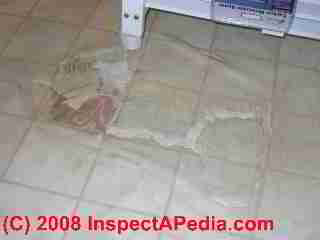
At LINOLEUM & SHEET FLOORING we describe the history and properties of linoleum sheet flooring using the Congoleum-Nairn corporation history to obtain some useful dates on when different sheet flooring products were produced.
The resilient flooring product shown at left was made in the late 1990's and is not an asbestos concern, though in this case the flooring was damaged by water and movement of a cabinet.
According to Rosato, "The original resilient floor coverings were developed during the latter part of the Nineteenth Century by Frederick Walton.
The original covering was linoleum for use as a floor decking on British naval ships." The composition of the original products included asphaltic binders to which an asbestos filler was added by mixing on a rubber mill.
Details are at
- CONGOLEUM-NAIRN FLOORINGand Congoleum Flooring History
- LINOLEUM & OTHER SHEET FLOORING
- RESILIENT SHEET FLOORING ID GUIDE
- SHEET FLOORING INSPECT / TEST
Stone Floors - Slate, Granite, Limestone, Marble
These are natural materials cut into flooring tiles. Terrazzo is made of marble chips set in concrete, usually laid in squares defined by lead beading. The surface is polished to give a smooth floor. Terrazzo is more common in commercial buildings, hospitals and schools than in homes.
Stone and terrazzo are good flooring materials because of their strength, appearance and durability. Installation considerations are similar to ceramic and quarry tile, in that the weight of the material itself may deflect conventional flooring systems. Joints on stone floors are grouted.
- Citation: Carson Dunlop Associates, Home Reference Book
Tile Flooring - ceramic
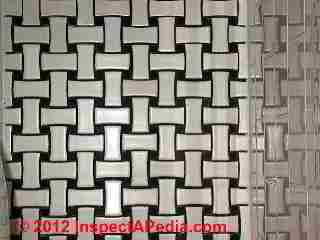 Generally considered high quality, ceramic or quarry tiles are hard, fired-clay products that may be glazed or unglazed. These materials stand up well to heat, water and normal wear and tear, and have good resistance to stains and cuts. These brittle floor systems will crack if not well supported.
Generally considered high quality, ceramic or quarry tiles are hard, fired-clay products that may be glazed or unglazed. These materials stand up well to heat, water and normal wear and tear, and have good resistance to stains and cuts. These brittle floor systems will crack if not well supported.
A conventional wood flooring system often has too much flex to support ceramic or quarry tile. Better installations include a concrete base for the tile, typically one to five inches thick.
Ceramic tiles may be pressed into the concrete while it is setting. Joints are then grouted. Tiles are typically 1/16-inch to 1-inch thick and are commonly from one inch by one inch to 24 inches by 24 inches. Many shapes, colors, patterns and finishes are available.
In modern construction, a thin mortar base or adhesive is used over a thick subfloor. If well installed, this can be satisfactory. Again, joints have to be appropriately grouted. It is common for ceramic or quarry tile floors to be cracked where floor joists deflect, or in heavy traffic
patterns. Tiles can be damaged by dropping tools, pots, pans or other heavy objects.
Traditionally, ceramic tile floors were used in bathrooms and vestibules, because of their natural resistance to moisture. Ceramic or quarry tile floors are used in kitchens, for the same reason, although they are unforgiving if one drops glass on them, and they are also more
tiring to stand on because of their hard surface. Wet floors can be slippery. - Citation: Carson Dunlop Associates, Home Reference Book
See details about ceramic tiles at
- FLOOR, CERAMIC TILE
- CERAMIC TILE, ASBESTOS / LEAD?
Also see tile flooring discussed at
FLOOR RADIANT HEAT Mistakes to Avoid|
Tile Flooring - resilient, vinyl, vinyl-asbestos
- FLOOR TILE HISTORY & INGREDIENTS
- Vinyl Asbestos Flooring Information: Tiles & Sheet Flooring
Tile Floor Inspection, Diagnosis, Repair
Cracked floor tiles like this can be diagnosed in order to decide if the cracking shows a serious structural problem, inadequate floor support, mechanical damage, or as in this case, damage from a loose, rocky toilet.
MORE PLACES TO LOOK for Hidden Mold in buildingsincludes a discussion of how even a slight slope in a tile bathroom floor leads to bath leaks under and behind bathroom vanity cabinets and floor trim, and we discuss how to prevent this problem
Vinyl Asbestos Floor Tiles - 1930 - 1976 (est)
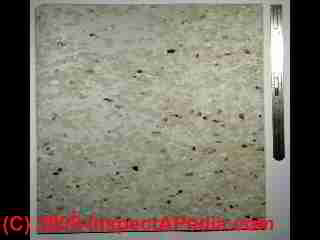 Vinyl floor tiles, including vinyl-asbestos floor tiles and homogenous vinyl floor tiles (non-asbestos product) are almost as old as asphalt floor tiles. By the early 1950's in the U.S. vinyl tile floor products were more popular than asphalt-based flooring. The reason is pretty obvious.
Vinyl floor tiles, including vinyl-asbestos floor tiles and homogenous vinyl floor tiles (non-asbestos product) are almost as old as asphalt floor tiles. By the early 1950's in the U.S. vinyl tile floor products were more popular than asphalt-based flooring. The reason is pretty obvious.
Asphalt-based flooring as it was originally produced used heavy asphalt products which meant that the floor tiles could be made in dark colors only. Soon after asphalt-asbestos floor tiles were marketed manufacturers heard from their buyers that consumers wanted lighter floor tiles and tiles of varying color and pattern.
Organic resin vinyl increased in popularity for this reason, but slowly. By 1952, the production of vinyl plastic floor tile sales in the U.S. was about half the volume of asphalt floor tiles, selling 35 million square yards.
We discuss vinyl-asbestos floor tiles as an asbestos fiber source in buildings in more detail
at ASBESTOS FLOORING IDENTIFICATION
where we elaborate the concerns about asbestos used in the manufacture of vinyl based floor tiles that used high levels of asbestos fibers as a filler material and to provide other properties to that product. More photos of vinyl asbestos floor tiles, including microphotographs of vinyl-asbestos floor tiles can be seen at that article.
See these articles on asphalt and vinyl-asbestos floor tile identification:
- ASBESTOS FLOORING IDENTIFICATION - How to Identify Floor Tiles That May Contain Asbestos
- ASBESTOS FLOOR TILE IDENTIFICATION PHOTOS 1949-1959 - detailed photo guide to asphalt asbestos and vinyl asbestos floor tiles, 1900 -1986
- FLOOR TILE HISTORY & INGREDIENTS - history, dates, and description of the production process and ingredients in asphalt floor tiles, asphalt-asbestos floor tiles, & vinyl-asbestos floor tiles 1900 to present.
- FLOORING MATERIALS, Age, Types - Age of Building Flooring Materials - A Guide to Estimating Building Age, This article describes types and ingredients in flooring materials: Asphalt floor tile, Cork floor tile or planks, Laminate flooring (modern), Linoleum & older sheet flooring (painted canvas), Vinyl-asbestos floor tiles, Wood flooring.
- FLOOR TILE / SHEET FLOORING PHOTO GUIDES - list of photo guides
- FLOOR TYPES & DEFECTS - Asphalt floor tiles, asphalt-saturated asbestos felt, carpeting, cork floor tiles & planks, laminate flooring (modern), linoleum (sheet flooring) & earlier painted fabric floor coverings, vinyl-asbestos tile floors, wood flooring.
- ASBESTOS FLOOR TILE LAB PROCEDURES - photos of how vinyl asbestos flooring is analyzed in the lab.
Wood Flooring & Engineered Wood Floors
Hardwood Flooring, the Basics
Hardwood floors are traditionally oak, although other woods such as cherry, walnut, birch, beech, mahogany, elm and maple, are also used. Bamboo is not technically wood, but is also used as flooring. Hardwood flooring may be in the form of strips or parquet, which often consist of six inch squares with each square made up of six one-inch strips.
The squares are laid with the grain in adjoining squares at right angles, giving a checkerboard effect. Parquet flooring may be nailed or glued down. There are several different types and installation techniques.
Parquet flooring can also be made up of a combination of rectangles, triangles and lozenges and can be very decorative and very expensive.
Strip flooring is typically tongue and groove, secured with nails driven diagonally through the tongues into the subfloor. Hardwood flooring in modern construction is typically 3/8 inch to 3/4 inch thick and may be pre-finished or finished on site.
Hardwood flooring is a high quality and durable floor system. It can be mechanically damaged, attacked by termites, rot and fire, or damaged by water.
Wood flooring is not ideally suited to kitchen and bathroom areas, since it is susceptible to water damage. Nonetheless, hardwood flooring is regularly found in kitchens. Individual boards can be replaced, but matching can be tricky.
Worn 3/8 inch thick hardwood flooring can be sanded once to provide a new wood surface. 3/4 inch hardwood flooring can be sanded several times before the tongues are exposed. Wood flooring can be covered with carpeting or other flooring materials. - Citation: Carson Dunlop Associates, Home Reference Book , quoted with permission.
Wood Flooring Inspection, Diagnosis, Repair
Wood flooring, one of the most warm and beautiful materials that can be placed in a home (OPINION-DF) needs to be installed following proper practices.
The gaps that appeared in the wood floor shown at above left were caused by installation of the floor in a new home, over radiant heat tubing, and without allowing the flooring to reach a proper moisture level before it was nailed in place.
See those details
at GAPS in RADIANT HEATED WOOD FLOORS - caused by running the radiant heat at too-high a temperature
Extreme buckling can cause an upwards explosion of a wood floor when flooring is exposed to flooding or prolonged leaks.
This severe buckling wood floor damage can occur even at much smaller increases in interior moist sure if a tongue and groove wood floor is improperly installed - leaving inadequate free space margin around the floor perimeter.
See WOOD FLOOR TYPES for a catalog of types and ages of wood flooring.
See WOOD FLOOR DAMAGE REPAIR for details of types of damage to wood flooring and for a description of wood floor repair approaches.
- Engineered wood flooring (shown above)
is similar to laminate flooring, except the thin top layer is actually hardwood that is bonded to a base that may be hardwood, plywood, or high-density fiberboard. The hardwood layer is usually pre-finished. The floor may be sanded and refinished, depending on the thickness of the hardwood layer.
Engineered wood flooring may be installed as a floating floor, or it may be glued, stapled, or nailed in place. - Citation: Carson Dunlop Associates, Home Reference Book , quoted with permission.
See details at LAMINATE FLOORING - Engineered Wood Floors - Softwood Wood Flooring:
Pine is the most common softwood flooring. Fir and cedar are also used.
Pine floors were typically used as a subfloor or as finish flooring in a 1x4 tongue-and-groove configuration. When used as a subfloor below hardwood, the softwood was typically laid in 1x4 or 1x6 planks, perpendicular or diagonal to the floor joists. The boards were typically separated slightly to allow for expansion. - Softwood subflooring
used under linoleum or other thin kitchen floor coverings was usually tongue-and-groove and tightly fit to provide a smooth, continuous surface to support the flexible flooring system.
Modern construction often includes 1/4 inch plywood underlayment between the subfloor and finish flooring to provide a smooth surface for the finishing material. - Citation: Carson Dunlop Associates, Home Reference Book , - LAMINATE WOOD & Other Laminate Floors
- Also see LAMINATE FLOORING where we describe plastic laminate floors in this article
- FLOOR WOOD AGE TYPES HISTORY
- FLOOR WOOD, DAMAGE DIAGNOSIS
- FLOOR, WOOD ENGINEERED, LAMINATE, INSTALL
- FLOOR, WOOD FINISHES
- FLOOR, WOOD INSTALLATION GUIDE
- FLOOR, WOOD MOISTURE
- FLOOR, WOOD RADIANT HEAT
- FLOOR, WOOD SOLID STRIP, PLANK
- FLOOR, WOOD TYPES
- GAPS in RADIANT HEATED WOOD FLOORS - caused by running the radiant heat at too-high a temperature
Guide to Inspection & Diagnosis of Flooring Materials in buildings
List of Non-Resilient & Resilient Floor Coverings Used in buildings
Definitions of Non-resilient Flooring & Resilient Flooring
Non-resilient floor coverings used in buildings that can assist in determining the age of a structure include bamboo, brick, concrete, stone, slate, and a wide variety of wood products.
Definition of non-resilient flooring:
"Non-resilient" flooring is defined as hard surfaced flooring material such as stone, brick, slate, or ceramic tile.
Definition of resilient flooring
"Resilient flooring" is defined as materials softer than the non-resilient materials we just listed (stone, slate, brick, ceramic tile), and includes organic types of flooring: asphalt based floor tiles, cork floor tiles, cork floor planks, linoleum sheet flooring (antique & modern), plastic floor tiles, rubber floor tiles, vinyl-asbestos floor tiles.
So what's "wood flooring" ? After all, it is organic too. Is a wood floor non-resilient, resilient, or just "wood"?
See Asphalt & Vinyl Floor Tile History - history, dates, and description of the production process and ingredients in asphalt floor tiles, asphalt-asbestos floor tiles, & vinyl-asbestos floor tiles.
Cork floor tiles were considered a warm, quiet, but less durable resilient floor covering than some of its competitors. It was sold often for use in residential dens, family rooms, or other warm, low-traffic areas, and it may have been popular (research needed) for use in areas where workers had to spend long periods standing - where it would have competed with rubber floor coverings. In 1952 cork flooring sales made up 2% of total floor tile sales. -- Rosato p88.
Details about cork flooring are at CORK FLOORING & FLOOR TILES
and also at FLOORING COMPANIES (see Armstrong Corporation).
Tables Comparing the Properties of Kitchen & Bathroom Flooring Options: Cost, Radiant Heat Use, Pros, Cons, Recommendations
[Click to enlarge any image or table]
...
Reader Comments, Questions & Answers About The Article Above
Below you will find questions and answers previously posted on this page at its page bottom reader comment box.
Reader Q&A - also see RECOMMENDED ARTICLES & FAQs
On 2021-05-18 - by (mod) -
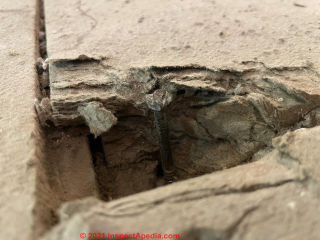 @Joanne Hanson,
@Joanne Hanson, That looks like an insulating fiberboard used as an underlayment. Check out the fiberboard identification examples found at
https://inspectapedia.com/structure/Fiberboard-Sheathing-Identification-Key.php FIBERBOARD SHEATHING IDENTIFICATION
They are you will see fiberboard products that are gray in color such as Homasote
On 2021-05-18 by Joanne Hanson
Does anyone know what this material is?
[Photo above]
It was under the carpet of a 1980’s condo we just bought. It’s badly warped and feels almost like a porous cardboard type material.
For context the condo is above an indoor swimming pool, so not sure if it’s a special type of floor because of that? Not even sure if it’s a subfloor or underpayment? Any help would be appreciate. Thank you
On 2020-05-26 - by (mod) -
Looks a bit like a cherry-wood floor, Karen. But I'd never expect to see cherry wood boards on an exterior porch exposed to the weather.Your later photo shows what looks like a think laminate floor (cherry?) applied over an older T&G or shiplap joined flooring.
Still thinking.
It would be helpful to know the country and city where the building is located
On 2020-05-26 by Karen Fox
Another image with details from the downdraft in the floor where you can see the thickness over some other wood
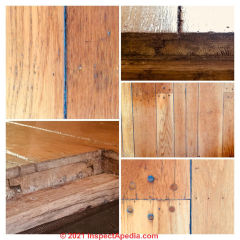
I’m trying to discover what type of wood flooring we have? House was built in the 1930s I’ve no idea when the floor was put in except pre 1960 when my parents bought the house, unless it was original. I want to put in matching flooring in the dining room which is adjacent but was originally a porch.
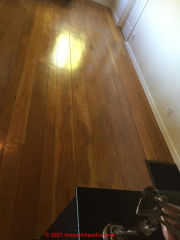
On 2020-05-04 - by (mod) -
Philip:That looks like wood, but from just the surface photo I can't say if it's a wood veneer or laminate or if instead it's a pre-finished solid wood flooring.
If you see in an area of damage that the color or wood pattern of the floor is very thin, perhaps even just a membrane of plastic like material, then it's certainly a laminate type flooring, perhaps built over chipboard.
If you checked the little box found to the right of the add image button and labeled "email me replies" then you'd be notified of any replies to your question/post, and that notice would include the web page URL where you posted.
See LAMINATE FLOOR DAMAGE REPAIR
On 2020-05-04 by Philip di Domenico
Hi,
I was wondering if anyone might be able to identify the type of flooring in the attached photo. As you can guess, I'd like to repair the ding.
This is my first visit to this site, and I am therefore unfamiliar with the question-posting etiquette and apologize in advance for any mistep. I include my email below since I am not sure how to get back here.
Thank you very much for your patience and for any help.
Best regards,
Philip di Domenico
ptd18b@gmail.com
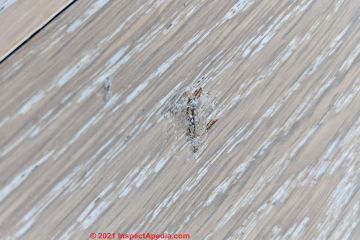
On 2020-04-08 1 - by (mod) - - by (mod) - identify hand-scraped wood flooring: types, solid wood vs engineered wood floors
 Alex
Alex
I'm not sure, and I think nobody can be sure, what flooring is installed in your photo without more information.
That's because there are several flooring materials that, from a distance, may look the same.
That said, your photo looks like a pre-finished wood or wood-veneer floor - in a pattern called "hand-scraped wood flooring".
You can see flooring that looks like the picture you posted in a nearly-identical photo at
https://newfloorsinc.com/wp-content/uploads/2019/11/hand-scraped-hardwood-flooring.png
provided by
New Floors, Inc.,
182 Old Town House Rd, Yarmouth, MA, 02673 USA
855-844-2779
newfloorscapecod@gmail.com
and shown below.
But it could of course be a manmade material.
A wood floor is more suitable for a living room than a kitchen where spills, water, food, and concentrated traffic areas such as in front of a sink or stove can create local wear areas that are better handled by a resilient type floor covering.
Really?: The floor in your photo may not be solid wood.
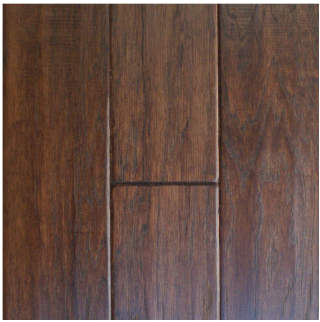 It could be an engineered wood floor such as sold through Home Depot stores as "Hand Scraped Hickory Cocoa 3/8 in. Thick x 4-1/4 in. x Random Length Engineered Click Hardwood Flooring(20 sq. ft./case)" that I will show below.
It could be an engineered wood floor such as sold through Home Depot stores as "Hand Scraped Hickory Cocoa 3/8 in. Thick x 4-1/4 in. x Random Length Engineered Click Hardwood Flooring(20 sq. ft./case)" that I will show below.
Home Depot describes this engineered wood floor (that means it's a laminate product not solid wood) as
Made from real Hickory, this Engineered Click Hardwood Flooring comes from naturally occurring sources that add a unique beauty to your home decor.
Each plank features a 3/8 in. thickness and a Janka hardness rating of 1820. The flooring is made from five layers of solid wood that is bonded together for added durability.
But it could of course be a manmade material.
For example, shown here is Lamton Laminate - 12mm Wide Board Collection flooring style Hickory Ebony / 12 / AC3 [image file] sold by "BuildDirect" is similar though those long shallow gouges are not apparent in this latter floor.
A wood floor is more suitable for a living room than a kitchen where spills, water, food, and concentrated traffic areas such as in front of a sink or stove can create local wear areas that are better handled by a resilient type floor covering.
On 2020-04-08 by Alex - by (mod) - please identify the flooring material shown below
Please identify the flooring material and your feedback on this type used in living room/kitchen. Picture is attached.
Thnx
On 2019-11-11 6 by (mod) - by (mod) - black mastic bleed-through at vinyl floor tile joints
Tom
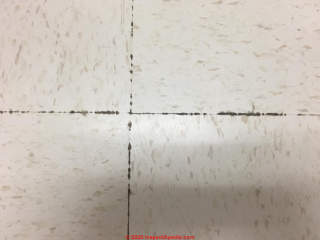 I suspect you are seeing black asphalt-type floor tile adhesive mastic or "cutback" adhesive.
I suspect you are seeing black asphalt-type floor tile adhesive mastic or "cutback" adhesive.
You can confirm that by dissolving a small amount of the ooze in odorless paint thinner.
Watch out: for floors installed up to the mid 1980s it's quite possible that that adhesive contains asbestos. That's not a reason to panic but it is a reason to investigate further. If the mastic contains asbestos the floor tile may as well.
See details at FLOORING ADHESIVE MASTIC SEALANTS
and at ASBESTOS-CONTAINING ADHESIVES
On 2019-11-10 by Tom Reynolds - by (mod) -
I have a quick question. I have black stuff coming up in the seams of my floor tiles in certain areas of the classroom where I work.
We had testing done for mold and the testing didn't show mold but to be on the safe side we had the area cleaned.
Everything looked good for about a month and now I'm seeing the same stuff start to pop up. The testing people thought we were probably dealing with mastic that was coming up due to a temperature imbalance between the floor and the room.
I'm in Phoenix where our temperatures outside can go up to 115 and my classroom is a chemistry room so I try to keep the temps in the 70's. Since it has cooled down I am once again noticing this.
Any thoughts. I'm concerned about mold as this is an old building and this is the second time I am seeing this.
What is in the picture occurred within 2 months of a large cleaning. Any advice would be appreciated.
Question:
(Nov 28, 2012) Ann said:
my parents house was built in 1962. (Single dwelling concrete block)We recently pulled up the carpet after 25 years and there is a tile of some sort that I am trying to identify.
It doesnt look like its grouted and its doesn't feel like vinyl. Can you help me identify it?
Reply:
Ann you can send us a photo for comment using the page bottom CONTACT link to find my email, or you can yourself see ASBESTOS FLOORING IDENTIFICATION - home
...
Continue reading at FLOOR DAMAGE DIAGNOSIS or select a topic from the closely-related articles below, or see the complete ARTICLE INDEX.
Or see these
Recommended Articles
- CERAMIC TILE DAMAGE REPAIR
- CORK FLOORING & FLOOR TILES
- FLOOR DAMAGE DIAGNOSIS
- FLOOR, STONE, GRANITE, MARBLE, AGGLOMERATE
- FLOOR TILE HISTORY & INGREDIENTS
- LAMINATE FLOOR DAMAGE REPAIR
- LAMINATE PLASTIC FLOOR
- LINOLEUM SHEET FLOORING
- WOOD FLOOR AGE TYPES HISTORY
- WOOD FLOOR ENGINEERED & SOLID
Suggested citation for this web page
FLOOR TYPES & DEFECTS at InspectApedia.com - online encyclopedia of building & environmental inspection, testing, diagnosis, repair, & problem prevention advice.
Or see this
INDEX to RELATED ARTICLES: ARTICLE INDEX to BUILDING FLOORING
Or use the SEARCH BOX found below to Ask a Question or Search InspectApedia
Or see
INDEX to RELATED ARTICLES: ARTICLE INDEX to BUILDING INTERIORS
Or use the SEARCH BOX found below to Ask a Question or Search InspectApedia
Ask a Question or Search InspectApedia
Try the search box just below, or if you prefer, post a question or comment in the Comments box below and we will respond promptly.
Search the InspectApedia website
Note: appearance of your Comment below may be delayed: if your comment contains an image, photograph, web link, or text that looks to the software as if it might be a web link, your posting will appear after it has been approved by a moderator. Apologies for the delay.
Only one image can be added per comment but you can post as many comments, and therefore images, as you like.
You will not receive a notification when a response to your question has been posted.
Please bookmark this page to make it easy for you to check back for our response.
IF above you see "Comment Form is loading comments..." then COMMENT BOX - countable.ca / bawkbox.com IS NOT WORKING.
In any case you are welcome to send an email directly to us at InspectApedia.com at editor@inspectApedia.com
We'll reply to you directly. Please help us help you by noting, in your email, the URL of the InspectApedia page where you wanted to comment.
Citations & References
In addition to any citations in the article above, a full list is available on request.
- Bagnall, Arthur G., and James A. Taylor. "Floor construction." U.S. Patent 1,235,636, issued August 7, 1917.
Patent disclosure excerpts:
This invention relates to building construction, and particularly to a mode of construction whereby floors may be rapidly and economically laid in a fire-proof manner, with great rigidity, and with v the use of cheaper materials and more expeditious methods than any heretofore in use.
The floor constructions now principally in use are the following:
first, the plain wood floor consisting of spaced parallel wooden joists having the flooring boards secured to their upper edges and lath for the ceiling below secured to their lower edges;
second, the tile floor made of hollow interlocking burnedclay tile suitably reinforced by metal members and carrymg above a floor of wood boards or concrete, and having secured to their lower faces the plaster forming the ceiling of the room beneath;
third, the reinforced concrete slab run into wood molds which are afterward taken away, a wood or concrete floor being laid upon the upper surface and the plaster for the room beneath secured to the lower surface, adhesion being secured by means of tile plates paintsurface, or other expedients.
The first of these is notoriously inflammable and is prohibited by ordinance in a great many cities and towns, especially for buildings of a public or semi-public nature or thoseabove a certain size; also the increasing price of lumber is rendering such construction less desirable The last two constructions are notoriously expensive, the expense of the second method being caused largely by the high cost of the tilin and the labor to set the same, and of the t ird method by reason of the great expense of lumber necessary to make the molds and forms, the costof erectin those forms, and the long period required for setting of the concrete, during which time other work on the building is practically suspended.
According tofour invention, thin and light joists, preferably bent up out of sheet metal, are substituted for the wooden joists of. the first method, and to the lower edges of these olsts are secured boards, plates, or slabs of some suitable i mperforate incombustible material, forming with the joists large molds in which is poured a suitable cementitious or the floors, and forms a very, efiective fire shield, although having very little tensile strength.v Upon the upper surface of this structure there is laid a wearing surface of boards, concrete, mosaic, or the like and to the lower surface is applied the plaster formin the ceiling of the room beneath. Suitab e tie rods are employed between adj acent joists, while tension members may also be employed'to stiflen the same and guard against sagging of the floor.
...In Fig. 3 we have shown a modified form of construction in which the members 1414, instead of being molded to interlock with the joists, are formed merely of wide flat sheets 1 1 -14: of plaster boards, sackett board, or other suitable composition held in place by the wire staples 3030 whose legs are twisted about suitable rods 31-31 whose ends rest upon the flanges 77. - Our recommended books about building & mechanical systems design, inspection, problem diagnosis, and repair, and about indoor environment and IAQ testing, diagnosis, and cleanup are at the InspectAPedia Bookstore. Also see our Book Reviews - InspectAPedia.
- In addition to citations & references found in this article, see the research citations given at the end of the related articles found at our suggested
CONTINUE READING or RECOMMENDED ARTICLES.
- Carson, Dunlop & Associates Ltd., 120 Carlton Street Suite 407, Toronto ON M5A 4K2. Tel: (416) 964-9415 1-800-268-7070 Email: info@carsondunlop.com. Alan Carson is a past president of ASHI, the American Society of Home Inspectors.
Thanks to Alan Carson and Bob Dunlop, for permission for InspectAPedia to use text excerpts from The HOME REFERENCE BOOK - the Encyclopedia of Homes and to use illustrations from The ILLUSTRATED HOME .
Carson Dunlop Associates provides extensive home inspection education and report writing material. In gratitude we provide links to tsome Carson Dunlop Associates products and services.


